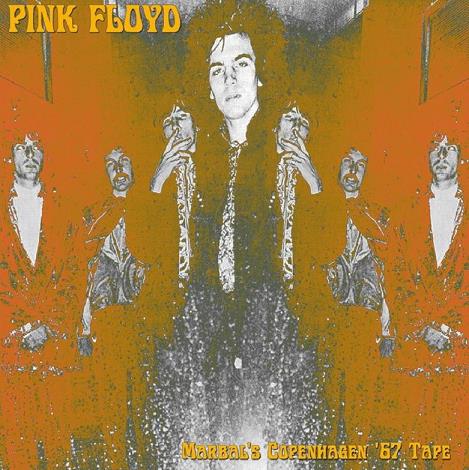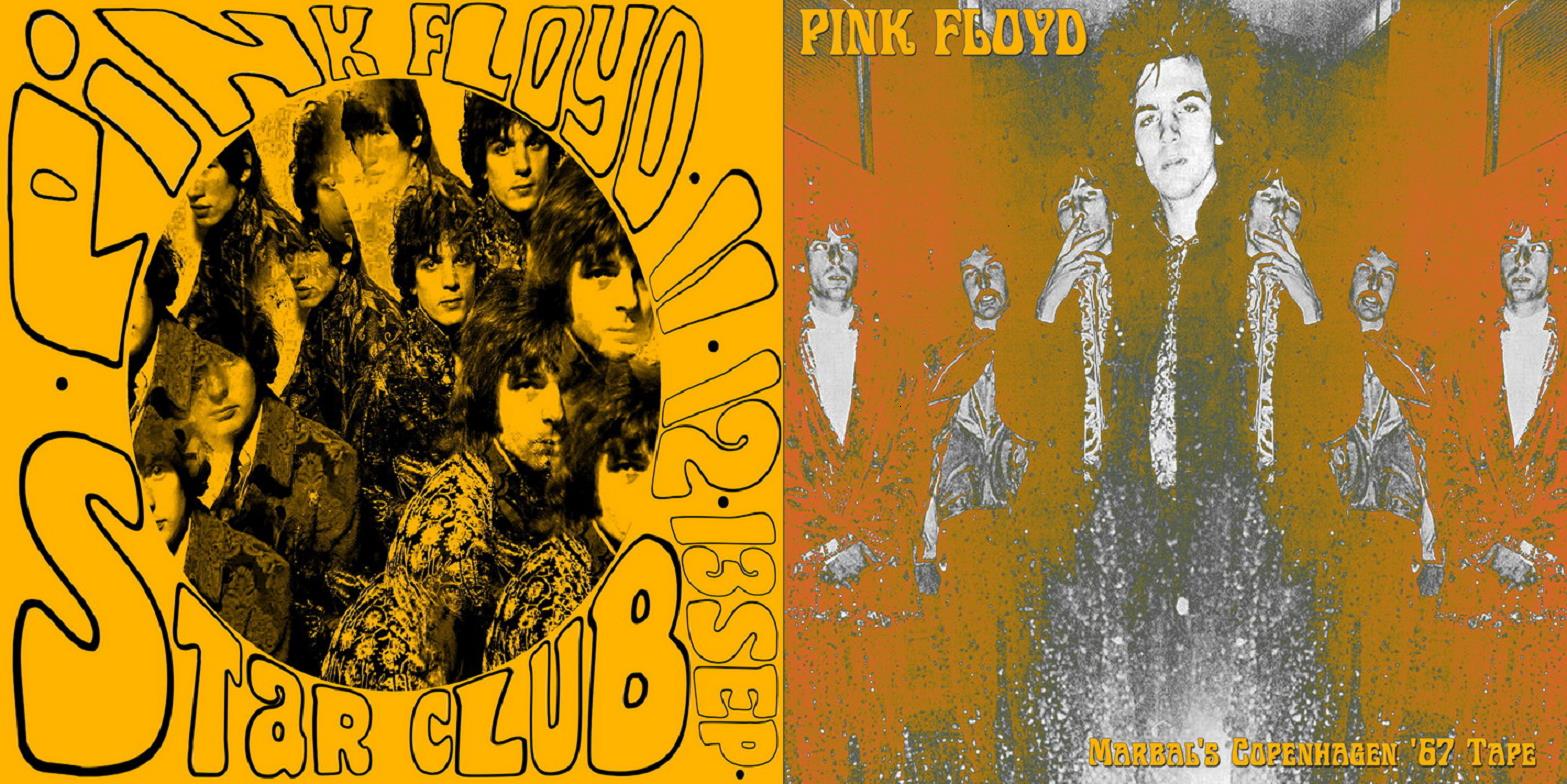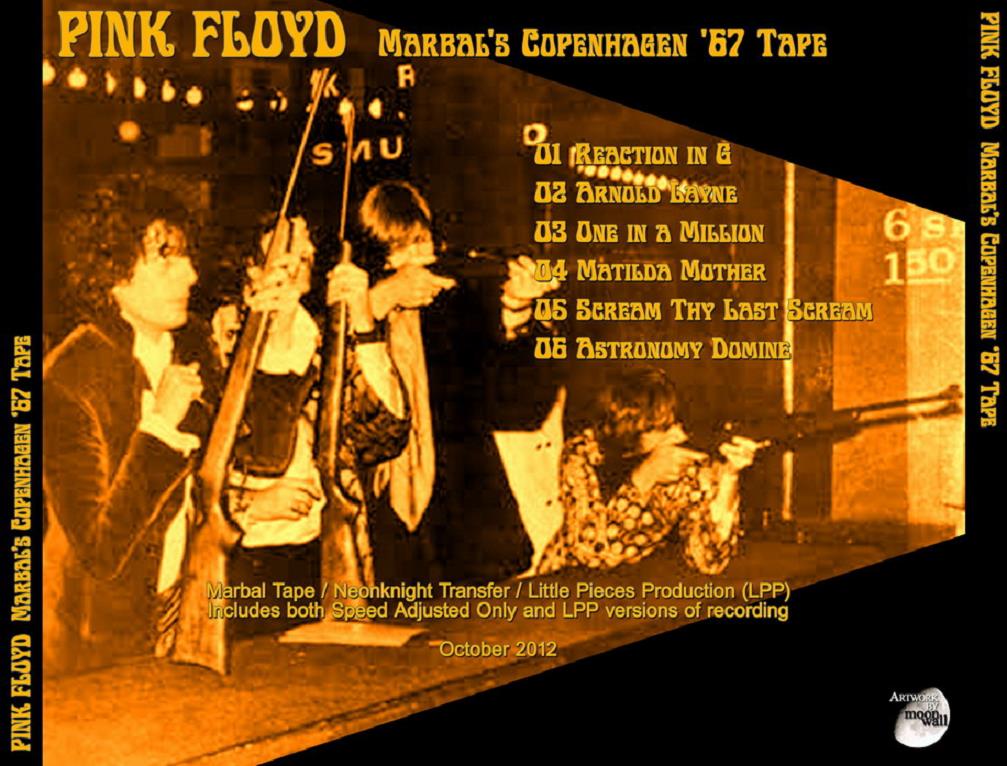MARBAL’S COPENHAGEN TAPE
Date : 13/09/1967
Lieu : Star Club, Copenhague (Danemark)
Label : Little Pieces Production
Support : 1 cd
Durée : 36:51 mn
Source : Audience
Qualité sonore : 5/10
Liste des titres :
01. Reaction in G (6:33)
02. Arnold Layne (3:56)
03. One in a Million (6:27)
04. Matilda Mother (6:50)
05. Scream Thy Last Scream (5:33)
06. Astronomy Domine (7:29)
Commentaire : Ceci est l’un des tout premiers concerts de Pink Floyd qui aient été enregistrés et qui soient disponibles en bootleg! De plus, c’est l’un des trois seuls concerts complets où l’on puisse entendre Syd Barrett à la guitare et (vaguement) au chant. (Le second étant le concert de Rotterdam, deux mois plus tard – voir ici et le troisième le concert au Golden Circle de Stockholm le 10 septembre 1967). Le son est très médiocre mais quand même suffisant pour se faire une idée des concerts des tout débuts de Pink Floyd. Il en existe beaucoup de versions, qui varient un peu en durée et en qualité. A mon goût, les meilleures versions sont celles disponibles sur les bootlegs « Wonderful, wonderful Copenhagen » et sur celui-ci.
Informations supplémentaires sur cette version :
***Neonknight’s Notes***
Grolsch kindly assisted us with the background to this recording. Copenhagen ’67 was taped by a local musician called Carsten V. Michael K borrowed his master and made a copy. Marbal’s cassette is likely in turn to have been copied from a 7.5 ips open reel transfer of Michael K’s reel. There are no digital clones from the master or first gen Michael K reel but both still exist and remain in the hands of the owners. Perhaps we can look forward to one or both of them surfacing one day.
A 3rd gen reel from the collection of the late Bernard White is often considered to be the best source for this concert. A friend has Bernard’s reel and a 2001 transfer was sent to Eskimospy for use by Harvested in August 2005 for their ‘What Syd Wants’ release. The lineage for Bernard’s reel went something like Carsten V > Michael K > UK collector > Bernard in the mid 1970s.
Marbal’s 3rd gen cassette has been transferred before by other collectors and they were not able to bring out the best in the recording. Marbal’s copy, like his Rotterdam tape, is much cleaner with a tighter top end, and a fuller, more natural sound when compared to Bernard’s.
Listen carefully to Littlepieces’ re-master and you you can distinguish each instrument and follow it if you care to. You will also hear subtle details such as the clink of a glass at 11.39 and Reaction in G being counted in, that you probably will have not noticed before. I believe it’s also possible to appreciate the ambience of the venue.
There is no getting away from the fact that the quality of this recording varies. However, Littlepieces has done an excellent job smoothing the imperfections out on the LPP version, particularly the many distortions that often contribute to burying the sound.
This is a strong, loud performance by the band which was sometimes too much for Carsten V’s recorder to cope with. Listen out for Matilda Mother, which reminds me of the Underground Scene Special UFO version, and a lively Scream Thy Last Scream. Thank you Marbal for entrusting me with your tape!
***Littlepieces’ Mastering Notes for – Marbal’s Copenhagen ’67 Tape – Speed Corrected Only version***
All torrented unprocessed sources for this recording seem to share the same SQ and level fluctuations. The fact that the two lowest gen torrented sources, BWs 3rd gen reel and Marbal’s 3rd gen cassette, have these as well, seems to indicate they are also on the 2nd gen sources they were copied from.
The SQ is dark and the levels change for over a minute and slowly improves til about 1:20m when it becomes fairly stable until shortly after 12 minutes. From here a subtle increase in the hiss begins with a slowly decreasing upper half. This continues with some periods of improvement until eventually it becomes pronounced and by the time it reaches AD, the recording has become much weaker. The level changes also become more frequent beginning near the end of ‘One in A Million’. There are many segments containing distortions and the frequency and intensity of these increase as the recording progresses. These give the impression that the recorder had his levels too high at times or his microphone was overwhelmed. As I said, all the mentioned artifacts are in all torrented unprocessed sources.
This recording was marked as Dolby encoded but we transferred it without Dolby. Transferring a Dolby encoded recording without decoding the Dolby on playback is done often when playing the tape back on a different deck than that which it was encoded. The differences in decks often results in the decoding profile varying from the original encoding creating a poor result. Though this recording did not have its Dolby decoded, the expected boost in the higher frequencies are not near as apparent as usual.
Marbal’s cassette is a mono recording that was dubbed with a stereo deck into a two channel recording. Due to the previous transfers with less than perfect head alignment, it has a minor phase shift that is generally from 2-5 samples. The output level of each channel is similar most of the time and after about 12m I could a hear a bit more high end in the left channel.
The speed was slow and was adjusted from 3.8% to 4.5%.
*Other than adjusting the speed, no other changes were made to the ‘Speed Corrected Only’ version.*
***Littlepieces’ Mastering Notes for – Marbal’s Copenhagen ’67 Tape – LPP version***
To accompany the ‘Speed Corrected Only’ version I have produced a LPP version in an attempt to provide a copy with less interference from artifacts, more detail, and more overall SQ continuity.
After testing each channel by itself and with the channels manually aligned, I decided to use only the left channel for approximately the 1st minute and then retain both channels and manually align through Arnold Layne, and use only the left channel from that point until the end of the recording. Using only the left channel should provide a bit more detail as the recording quality lessens after AL by including more high end and improved phasing.
The most time consuming part of this project was definitely the manual spectral cleaning. I removed many many of the usual tics, pops, bumps, etc, but more importantly I was able to remove most of the distortions that interfered with the recording.
I utilized and varied moderate noise reduction settings working mostly above 8kHz – 10khZ and only slightly lower on some audience sections while being diligent not to encroach on the harmonics. I could have worked the entire spectrum and squeezed most of the hiss out, but I generally don’t like what this does to the nature of the sound. As with Marbal’s Rotterdam recording, I think more aggressive NR, among other things, would have eliminated a sense of the acoustics of the small venue they are playing in.
As with Rotterdam, the EQ increases I used were applied to only the upper half which as the recording progresses and weakens is even more buried than Rotterdam. The quality of this source and transfer allowed me to use an increasingly aggressive EQ profile and lessen the degree of difference between the best and worst parts of the recording. The EQ curve was adjusted at times throughout the recording but mostly did not exceed ~8kHz. In addition I used a multiband enhancer to increase the bass output by reducing the base width (mono) in the lower portion of the low end and increasing the gain when it was left channel only.
There were many micro drop outs/downs, mostly ~20ms, and I either removed a short piece of damage or was able to use the other channel to repair the damaged segment. A few minor ones still remain as does some very short pieces of tape damage.
I selectively reduced some low frequency hums during the audience/tuning segments and near the end of AD. These seem to be present and prominent in all unprocessed sources.
Hopefully these changes allow a listener to progress through the recording without becoming so distracted by the artifacts and SQ and level changes. I think this rendition of Reaction In G is the best I’ve heard……..it really cooks after a few minutes. And I love the way One in A Million hits so hard……….I have a new appreciation for this track.
Marbal Tape / Neonknight Transfer / Little Pieces Production (LPP) October 2012
************************************************** ****************************************
*Assurez-vous que le téléchargement de ces fichiers ne contrevienne pas à la législation en vigueur.
Disponible ici en flac : http://www.guitars101.com/forums/f145/pink-floyd-1967-09-13-copenhagen-dk-aud-flac-148320.html#post1039075
Ou bien ici (en flac aussi) : http://www.guitars101.com/forums/f145/pink-floyd-1967-11-13-rotterdam-nl-aud-flac-146247.html#post1029568
Autres bootlegs du même concert dans ma collection :
Pochette :
Bootleg n°1246


